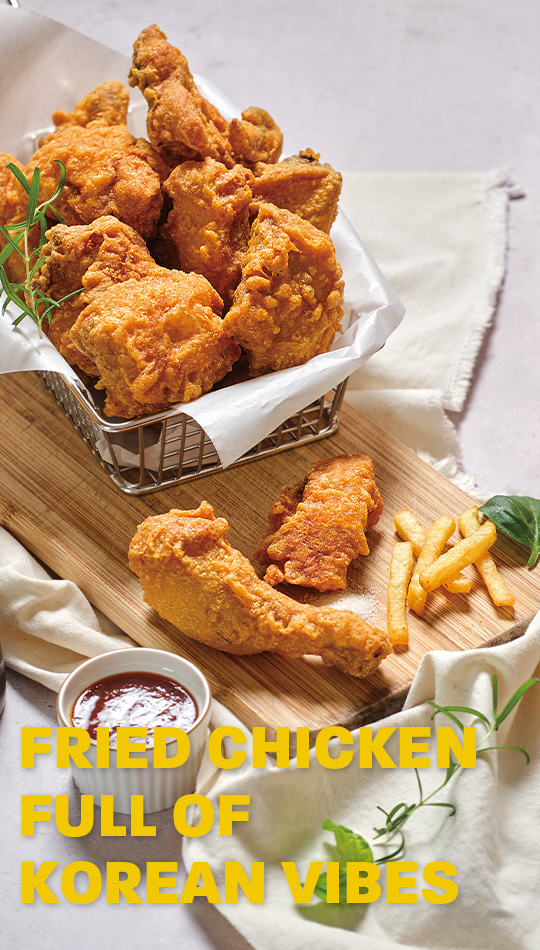Koreans have an unbridled love for fried chicken. Who can resist the crispy, crunchy skin coated with a tangy-sweet sauce, revealing tender, juicy meat with each bite? While fried chicken isn’t native to Korea, it’s morphed into something entirely different since its arrival. Now, it’s not just any food―it’s K-fried chicken, making its way onto tables worldwide with a “Korean” tag in front.


Writer. Jang Heejoo
The Journey to K-food Stardom
Korean fried chicken, currently winning over foreign hearts, has a tale that traces back to the 1950s when it first landed on Korean soil through the United States military. By the 1970s, thanks to rapid economic growth, mass-produced cooking oil and feed and improvements in chicken breeds, Korean fried chicken became a household name. In the 1980s, the chimaek culture―a compound word made up of chi for chicken and maek from maekju for beer―emerged, driven by various major sports events. People started ordering fried chicken for delivery while watching games at home, solidifying fried chicken as Korea’s go-to delivery food. The essence of Korean fried chicken, the yangnyeom chicken (seasoned fried chicken) sauce, was first developed during this time. To prevent the fried chicken from becoming tough when cold, a merchant devised a method of coating it with a mixture of corn syrup and gochujang (red chili paste).
Since then, Korea’s fried chicken industry has boomed. Fried chicken brands sprouted up overnight, unleashing an array of menu items. Korean fried chicken companies ventured overseas. Thanks to the media, the renowned chimaek culture etched “chimaek” in the Oxford Dictionary―solidifying Korean fried chicken’s status as the epitome of K-food.
While some may argue that Korean fried chicken is not authentic Korean food because its origin lies in the U.S., there’s no denying it’s a bona fide Korean dish, infused with Korea’s unique history and culture. A medley of sauces developed from Korean ingredients enhances the fried chicken, while Korea’s delivery and sports culture shapes its consumption. This is why Korean fried chicken is destined to be Korea’s iconic dish.
Exploring the Fascination of Fried Chicken
According to a document released by a Korean government department in January, Korean fried chicken takes the crown as foreigners’ favorite Korean menu item and the most consumed. Let’s dive into what sets Korean fried chicken apart from its traditional counterpart.
Korean fried chicken comes in all shapes and sizes―it’s a real smorgasbord of flavors. From the basic salt and pepper seasoning to the more adventurous choices like gochujang sauce, sauces based on boiled ganjang (soy sauce), cream sauce, blends of chili and mayo, garlic-infused sauces and even curry-based sauces―there’s something for everyone’s taste buds. And let’s not forget the cooking methods. It’s not just about frying―some places bake theirs in the oven, while others prefer the smoky flavor of charcoal grilling. Of course, every fried chicken place and brand has its own secret method of seasoning the fried chicken. Plus, there’s a plethora of creative twists―topping the fried chicken with kkwarigochumyeolchibokkeum (stir-fried shishito peppers and dried anchovies), which is a staple side dish, or dipping it in a mixture of corn and cheese. With such a variety, it’s no wonder Koreans have their own favorite “go-to” fried chicken.
Korean fried chicken is a breeze to devour. It’s a staple delivery option in Korea, thanks to its quick cook time. With delivery folks on standby round the clock, customers can get their fix anytime―day or night―with just a phone call or online order. While these qualities might not have been particularly appealing in the past, they gained attention with the onset of COVID-19 and social distancing.
Korean fried chicken―born from bursts of creativity―is a sight to behold for first-timers. Words can’t fully describe its taste, which is a shame. To truly grasp why the world is raving about this taste sensation, take a bite. Once you do, it will all make sense why everyone’s singing its praises.
Padak
(fried chicken with green onions)
20 mins.
INGREDIENTS
Frozen fried chicken, 2 green onions, 3 tablespoons ganjang, 1 tablespoon water, 1 tablespoon lemon juice, 2 tablespoons vinegar, 3 tablespoons corn syrup, 1/2 tablespoon mustard (optional), 2/3 tablespoon minced garlic, a pinch of black pepper
- Thinly slice the green onions and soak them in cold water.
- Mix mustard with vinegar until smooth, then add ganjang, water, lemon juice, vinegar, corn syrup or agave syrup and minced garlic. Store the sauce mixture in the refrigerator to keep it cool.
- Pour oil into a pot or pan and fry the frozen fried chicken. Once fried, drain the oil using a colander.
- Transfer the chicken to a serving dish. Garnish with green onion slices (after removing excess water) on top and pour the sauce over it.
Gochujang Yangnyeom Chicken
20 mins.
INGREDIENTS
Frozen fried chicken, oil, 8 tablespoons corn syrup or agave syrup, 4 tablespoons ketchup, 2 tablespoons gochujang, 2 tablespoons red pepper powder, 2 tablespoons ganjang, 2 tablespoons water, 4 tablespoons minced garlic, 2 tablespoons sugar, a little bit of parsley
- In a pan, add corn syrup or agave syrup, ketchup, gochujang, ganjang, water, red pepper powder, sugar and minced garlic in order, and boil until it thickens.
- Pour oil into a pot or pan and fry the frozen fried chicken. Once fried, drain the oil using a colander.
- Coat the fried chicken with the prepared sauce.
- Transfer the chicken to a serving dish and garnish with parsley.
